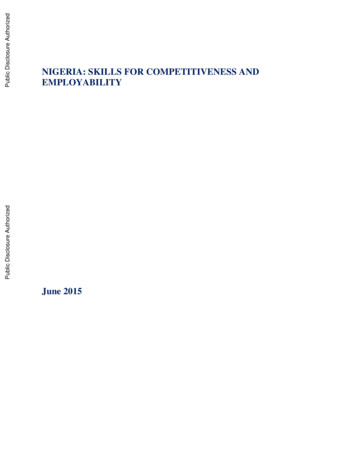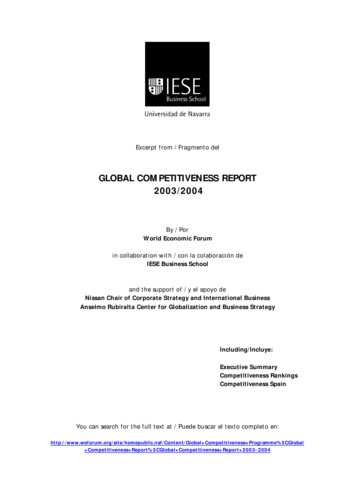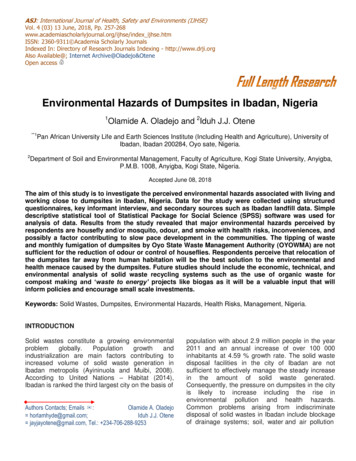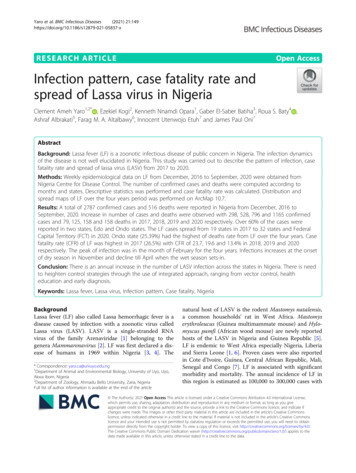
Transcription
Public Disclosure AuthorizedPublic Disclosure AuthorizedPublic Disclosure AuthorizedPublic Disclosure AuthorizedNIGERIA: SKILLS FOR COMPETITIVENESS ANDEMPLOYABILITYJune 2015
ACKNOWLEDGEMENTSThe study was led by Marta Favara (Economist) and Irajen Appasamy (Senior Operations Specialist), with thesupport of Marito Garcia (Principal Consultant). This study was prepared at the request of the federal governmentof Nigeria. The team gratefully acknowledges the significant contribution of Olatunde Adekola (Senior EducationSpecialist, GEDDR), who provided substantive guidance to the team’s review of Nigeria’s education landscape.He also led the dialogue and coordination held in two consultation workshops with multi-stakeholders for thereport in June 2014 and December 2014. The team also benefited greatly from the preliminary work by SamiraHalabi (Economist, GEDDR) and Martin Moreno (Consultant) who provided assistance in the analysis ofhousehold surveys. The team would also like to acknowledge Janet Adebo (GEDDR), Solomon Adebayo, andHadiza Eneche (AFCW2) for providing team assistance. Leslie Prpich provided technical editing services to thepolicy note.This policy note benefited substantively from the guidance of Indira Konjhodzic (Country Program Coordinatorfor Nigeria), Peter N. Materu (Education Practice Manager), and Marie-Francoise Marie-Nelly (Country Directorfor Nigeria). This policy note is a companion volume to the Nigeria jobs report entitled: More, and MoreProductive, Jobs for Nigeria – A Profile of Work and Workers (2015), which was led by Dena Ringold of theSocial Protection and Labor (GSPDR) Global Practice and Kathleen Beegle formerly of the World BankDevelopment Research Group for Poverty and Inequality, whose comments and contributions provided severalkey arguments in this report.The policy note greatly benefited from valuable feedback from participants at the stakeholder consultationworkshop held in Abuja on December 14, 2014, to discuss its preliminary findings. High-level participantsincluded ministers, CEOs, and directors general from key agencies, including the Federal Ministry of Education(FME), National Board of Technical Education (NBTE), Federal Ministry of Science and Technology, FederalMinistry of Industry, Trade and Investment, Industrial Training Fund (ITF), Tertiary Education Trust Fund,National Board of Technology Innovation (NBTI), National Agency for Science and Engineering Infrastructure(NASENI), Global Distance Learning Institute, National Office of Technology Acquisition and Promotion,National Space Research and Development Agency, National Information Telecommunications DevelopmentAgency (NITDA), and the Federal Institute of Industrial Research, as well as representatives from state Ministriesof Education of Ekiti, Anambra, and Bauchi. Also participated in the workshop were non-state stakeholders,including the Nigeria Economic Summit Group (NESG), Nigeria Society of Engineers, Nigeria EconomicsSociety, Federation of Construction Industry (FOCI), rectors and deans from five polytechnics and universities atstate and federal levels, and private-sector representatives of Huawei, AfriHUB Ltd, Riplington Associates, andHuman Capital Partners. International development partners from the U.K. Department for InternationalDevelopment (DfID), Japan International Cooperation Agency (JICA), African Development Bank (ADB), andU.S. Agency for International Development also participated.We acknowledge the contributions from peer reviewers of the report: Harsha Aturupane (Lead EducationSpecialist and Country Sector Coordinator, GEDDR); Nalin Jena (Senior Education Specialist, GEDDR); andKathleen G. Beegle (Program Leader, AFCW1). Additional comments were provided by John Speakman (LeadPrivate Sector Development Specialist, GTCDR); Lucy Fye (Senior Private Sector Development Specialist,GTCDR); Meskerem Mulatu (Lead Education Specialist); Olatunde Adekola (Senior Education Specialist);Shobhana Sosale (Senior Operations Specialist); Kebede Feda (Human Development Economist); Peter Darvas(Senior Economist, GEDDR); Foluso Okunmadewa (GSPDR); Khwima Nthara (Program Leader, AFCW2);Sateh Chafic El-Arnaout (Program Leader, AFCW2); Michael Wong (Lead Private Sector DevelopmentSpecialist, GTCDR); Andrew Gartside (Senior Private Sector Development Specialist, GTCDR); ObadiahTohomdet (Senior Communications Officer, AFREC); Halima Usman (Consultant, GTCDR; Vasco Molini(Economist, GPVDR); and Johanne Buba (Economist, GTCDR).i
ABBREVIATIONS AND AMOOCNABTEBNARNBTEAssessment of Core Competencies for Employability in the Services SectorAccess Nigeria Jobs Information SystemAgricultural Transformation AgendaAfrican University for Science and TechnologyBusiness Process OutsourcingCollege of EducationCorporate Affairs CommissionConditional Cash TransferCountry Partnership StrategyDepartment for International DevelopmentDemographic and Health SurveyEarly Childhood DevelopmentEarly Child Development IndexEducation Sector Support Program in NigeriaFederal Executive CouncilFederal Government CollegesFederal Inland Revenue ServiceFederal Ministry of EducationGross Domestic ProductGeneral Household SurveyGross National ProductHigher National DiplomaGross Attendance RateGross National IncomeHeavily Indebted Poor CountriesInformation and Communication TechnologyInfrastructure Leasing and Financial ServicesIndustrial Training FundInternational Standard Classification of Occupations version 1988International Development PartnersJoint Admission and Matriculation BoardLabor Force ParticipationLabor Market InformationLabor Market Information SystemLocal Government AuthorityLocal Government Education AuthoritiesManufacturers Association of NigeriaMultiple Indicator Cluster SurveyMonitoring Learning AchievementMassive Open Online CourseNational Business and Technical Examinations BoardNet Attendance RateNational Board of Technical Educationii
BEUBECUISUNESCOUNICEFUTMEWAECWASSCEYESSONational Council on EducationNational Commission for Colleges of EducationNational DiplomaNational Directorate of EmploymentNigeria Employers’ Consultative AssociationNational Examinations CouncilNigeria Education Data SurveyNot in Education, Employment, or TrainingNigerian Export Promotion CouncilNigeria Export Processing Zones AuthorityNigerian Educational Research and Development CouncilNigeria Economic Summit GroupNigeria General Household Survey - PanelNigerian Investment Promotion CommissionNigeria Information Technology Development AgencyNigeria Partners for DevelopmentNational Universities CommissionNational Vocational Qualification FrameworkNational Youth CorpsOccupational Information NetworkPost-Basic Education InstitutionSchool-Based Management CommitteeProfessional Open Online CoursePublic-Private PartnershipPupil-Teacher RatioSouth Africa’s Skills Education Training AuthoritySmall and Medium EnterprisesScience And TechnologyState Ministries of EducationSkills Toward Employment and ProductivityScience and Technology Post-Basic Education ProjectScience, Technology, Engineering, and MathematicsState Universal Basic Education BoardsTertiary Education Trust FundTrends in International Mathematics and Science StudyTechnical and Vocational Education and TrainingUniversal Basic EducationUniversal Basic Education CommissionUNESCO Institute of StatisticsUnited Nations Educational, Scientific, and Cultural OrganizationUnited Nations Children’s FundUnified Tertiary Matriculation ExaminationWest African Examinations CouncilWest African Senior School Certificate ExaminationYouth Employment and Social Support Operationiii
Report No. 96420-NGStandard Disclaimer:This volume is a product of the staff of the International Bank for Reconstruction and Development/the World Bank. Thefindings, interpretations, and conclusions expressed in this paper do not necessarily reflect the views of the executive directorsof the World Bank or the governments they represents. The World Bank does not guarantee the accuracy of the data includedin this work. The boundaries, colors, denominations, and other information shown on any map in this work do not imply anyjudgment of the part of the World Bank concerning the legal status of any territory or the endorsement or acceptance of suchboundaries.Copyright Statement:The material in this publication is copyrighted. Copying and/transmitting portions or all of this work without permission maybe a violation of applicable law. The International Bank for Reconstruction and Development/the World Bank encouragesdissemination of its work and will normally grant permission to reproduce portions of the work promptly.For permission to photocopy or reprint any part of this work, please send a request with complete information to theCopyright Clearance Center, Inc., 222 Rosewood Drive, Danvers, MA 01923,USA, telephone 978-750-8400, fax 978-750-4470,http://www.copyright.com/.i
TABLE OF CONTENTSACKNOWLEDGEMENTS . iLIST OF TABLES . iiLIST OF BOXES .iiiLIST OF FIGURES .iiiFOREWORD . viEXECUTIVE SUMMARY . ixCHAPTER 1. THE NIGERIAN LANDSCAPE IN JOBS, EDUCATION AND SKILLS . 1A. Introduction . 1Accelerating Nigeria’s economic growth and poverty reduction . 1Education and skills: Why are they so important to Nigeria’s growth and poverty reduction strategy? . 1B. Jobs in Nigeria . 4The current job landscape . 4Areas and sectors of likely demand for skills . 5A look at the future demand for skills . 5C. Education and skills profile of the Nigerian population and labor force . 9Education and literacy . 9Improvements in the education level of Nigerians . 13Country moving at two speeds . 14D. The skills content of the current workforce . 22Five categories of skills . 23CHAPTER 2. THE SHORTAGE OF SKILLS AND THE MISALIGNMENT OF SKILLS DEMAND ANDSUPPLY . 31A. Unemployment and underemployment: Structural problems . 31B. Imperfections in the skills supply market . 33Public and private provision of skills: Formal TVET, traditional apprenticeships, and informal training 33The Nigerian education and TVET systems: Complex with no clear accountability mechanism . 33Funding sources: Diverse and with poor accountability for results . 35National certification system: Not comprehensive and unresponsive to employers’ needs . 35Low capacity of post-basic and tertiary TVET . 38Low access to post-basic and tertiary TVET in relation to the needs of the economy . 38Gender disparity in technology and science education . 41Regional disparities in access to TVET . 41Poor quality of TVET system . 43Poor learning outcomes in secondary schools . 43Lack of qualified teachers and learning resources . 47C. Imperfections in the labor market . 48Lack of skills and incentives for investing in training . 48D. Imperfections in capital markets . 50Need for understanding of capital markets for education and skills development: Solving the lack ofaccess to financial means . 50E. Individual decision-making failures . 51Household and student decisions about post-basic education are not well informed . 51F. Planning and coordination failures . 51Issues with imbalance in skills demand and supply . 51Understanding demand for skills from the market and failures in planning: Poor market information andi
poor signaling of needs . 51Too many parastatals in the education sector complicate planning and coordination . 53G. Informal TVET Sector and Skills for the informal economy . 54CHAPTER 3. STRATEGIES FOR ACCELERATING SKILLS DEVELOPMENT TO SUPPORTECONOMIC GROWTH AND SHARED PROSPERITY . 56A. Capitalizing on Nigeria’s demographic dividend . 56B. Enhancing LFP and unemployed workforce . 58C. Exploiting the potential of the inactive and NEET population: Is it a youth phenomenon only? . 60D. Increasing productivity of the underemployed workforce . 62E. Improving outcomes for workers in the informal sector . 64F. New perspectives in addressing job market skills: A granular profile of Nigeria’s youngpopulation . 69G. Building a foundation for solid, sustained economic growth: Addressing out-of-school children . 76CHAPTER 4. OPERATIONALIZING SKILLS DEVELOPMENT STRATEGIES TO SUPPORTNIGERIAN ECONOMIC GROWTH AND SHARED PROSPERITY . 78A. Can Nigeria fulfill its potential? . 78B. A vision for accelerating economic growth through a new skills development framework . 78C. Key policy recommendations . 79D. Final note . 86Annex 1. State-level breakdown of education and data . 87Annex 2. Basic education and foundational skills . 111Annex 3. Geopolitical zones classification . 119Annex 4. STEP-B overview: Key innovations and outcomes . 120Annex 5. NaijaCloud microwork job creation: Global online outsourcing job skills for Nigerian youth 122Annex 6. Fab Labs: 21st-century digital fabrication skills. 123Annex 7. Massive open online courses for Nigeria . 125Annex 8. The returns to education in Nigeria . 126Annex 9. Skills content analysis methodology . 132REFERENCES . 135LIST OF TABLESTable 1-1. Education composition of Nigerian population across geopolitical zones (15–64 age group, 2011) . 15Table 1-2. Change in educational composition, comparing across cohorts (2011) . 17Table 2-1. Causes of the jobs and skills market failures . 32Table 2-2. NVQF levels and descriptors proposed for Nigeria . 37Table 2-3. TVET institutions by ownership (2010) . 38Table 2-4. Enrolment in mono-technics and polytechnics by education field (ND, HDN, %) . 39Table 2-5.Enrolment in polytechnics by zones (2009–2010) . 42Table 2-6. Federal government budget allocated to education (2008–2014) . 43Table 3-1. Labor force status (15–64-year-old population, 2011) . 59(percent) . 59Table 3-2. Labor force status by age groups, gender, and urban/rural (2011) (percent) . 60ii
Table 3-3. Education level of inactive and NEET population (15–64, 2011) (percent) . 61Table 3-4. Distribution of underemployment by age, gender, rural/urban (2011) (percent) . 62Table 3-5. Distribution of underemployment by education (15–64-year-old population, 2011) (percent) . 62Table 3-6. Underemployment rate by geopolitical zones (15–64-year-old population, 2011) (percent) . 63Table 3-7. Formal and informal employees by age groups, gender, urban/rural (2011) (percent) . 64Table 3-8. Distribution of formal and informal 15–64-year-old employees across economic sectors (2011)(percent). 67Table 3-9. Distribution of formal and informal 15–64-year-old employees across occupations (2011) (percent). 67Table 3-10. Literacy rate among formal and informal 15–64-year-old employees (2011) . 68Table 3-11. Distribution of formal and informal employees (15–64) by education level, 2011 (percent) . 69Table 3-12. Education profile of 15–24-year-old population by geopolitical zones, 2011 (percent) . 69Table 3-13. Literacy levels of 15–24-year-old population by geopolitical zones, 2011 (percent) . 70Table 3-14. Labor force status of 15–24-year-old population by geopolitical zones, 2011 . 70Table 3-15. Underemployed rate (15–24-year-old population, 2011) . 72Table 3-16. Distribution of underemployment by education (15–24-year-old population, 2011) (percent) . 72Table 3-17. Distribution of young employees across formal and informal sectors by education level (15–24-yearold population, 2011) (percent) . 73Table 3-18. Literacy rate among formal and informal 15–24-year-old employees, 2011 . 73Table A1-1. Education composition of Nigerian population across states (15–64 age group, 2011) . 87Table A1-2. Education composition of Nigerian population across states (15–24 age group, 2011) . 88Table A1-3. Illiteracy rate raw scores by state and educational level, 15–64, 2011 . 90Table A1-4. Illiteracy rate by state and educational level, 15–24, 2011 . 91Table A1-5. Raw skills scores by states (2009) . 94Table A1-6. Raw skills scores by states (2011) . 95Table A1-7. Labor force definition (LFP) and NEET (15–64-year-old population, 2011) . 97Table A1-8. Distribution of labor force status (LFP and NEET) 15–64 by state, 2011 . 98Table A1-9. Labor force definition (LFP) and NEET (15–24-year-old population, 2011) . 99Table A1-10. Distribution of labor force status (LFP and NEET) 15–24 by state, 2011 . 100Table A1-11. Labor force definition: Underemployment (15–64-year-old population, 2011) . 101Table A1-12. Distribution of labor force (underemployment) 15–64 by state, 2011 . 102Table A1-13. Labor force definition: Underemployment (15–24-year-old population, 2011) . 103103Table A1-14. Distribution of labor force (underemployment) 15–24-year-old by state, 2011 . 104Table A1-15. Labor force definition: Formal vs. informal (15–64-year-old population, 2011) . 105Table A1-16. Distribution of formal versus informal employees 15–64 by state, 2011 . 106Table A1-17. Labor force definition: Formal vs. informal (15–24-year-old population, 2011) . 107Table A1-18. Distribution of formal vs. informal employees 15–24 by state, 2011 . 108Table A2-1. Mean scores in ESSPIN teacher assessment by state . 115Table A2-2. Service delivery indicators at a glance . 116Table A8-1. The returns to education by economic sectors and across geopolitical zones . 129Table A8-2. The returns to education by countries . 130Table A8-3. The returns to skills . 131LIST OF BOXESBox 1. Shortage of reliable information on skills . 3Box 2. Illiteracy rates across states: Being at school and being illiterate . 12Box 3. Labor force definitions . 56Box 4. Characterizing the young: Evidence from the Nigeria Youth Survey . 73LIST OF FIGURESFigure 1-1. Nigeria: The returns of education, by economic sectors . 2Figure 1-2. Distribution of Nigeria’s population and labor force (15–64) in millions (2011) . 4Figure 1-3. Employment by sector, population aged 15–64 (1999, 2007, and 2011 (percent) . 5Figure 1-4. Many children are unable to read and add numbers after completing school . 9iii
Figure 1-5. Population and labor force literacy rate by education level (15–64-year-old population, 2011) . 10Figure 1-6. Share of illiterate population by geopolitical zone 8 (2009 and 2011) . 11Figure 1-7. Illiteracy rate by states (15–64-year-old population, 2011) . 11Figure 1-8. Share of illiterate population by economic sector (Panel A) and occupation (Panel B) . 12Figure 1-9. Illiteracy rate across states (15–64 years old, 2011) . 12Figure 1-10. Illiteracy gap by education level across states (16–64 age group, 2011) . 13Figure 1-11. Education composition by age groups (15–24; 25–34; 35–44; and 45-54, 2011) . 14Figure 1-12. Education composition of Nigerian population (15–64 age group, 2009 and 2011) . 14Figure 1-13. Percentage of population with up to primary education (15–64 age group, 2011) . 15Figure 1-14. Percentage of population with secondary education (15–64 age group, 2011) . 16Figure 1-15. Percentage of population with tertiary education (15–64 age group, 2011) . 16Figure 1-16. Gender gap in education composition across generations (female versus male education attainment,2011). 17Figure 1-17. Educational composition by economic sectors (15–64-year-old population, 2009–2011) . 18Figure 1-18. Educational composition by low/mid-value-added services subgroup, 2011 . 19Figure 1-19. Within-sector changes in educational structure (2007–2011) . 20Figure 1-20. Education composition by occupation (2011) . 21Figure 1-21. Education composition by occupations and skills level (2011) . 22Figure 1-22. Skills categories used in skills content analysis . 24Figure 1-23. Skills content of Nigerian economic sectors (2011) . 25Figure 1-24. Evolution of skills content of the Nigerian labor force in 2009 and 2011 . 25Figure 1-25. Evolu
for Nigeria), Peter N. Materu (Education Practice Manager), and Marie-Francoise Marie-Nelly (Country Director for Nigeria). This policy note is a companion volume to the Nigeria jobs report entitled: More, and More Productive, Jobs for Nigeria - A Profile of Work and Workers (2015), which was led by Dena Ringold of the










